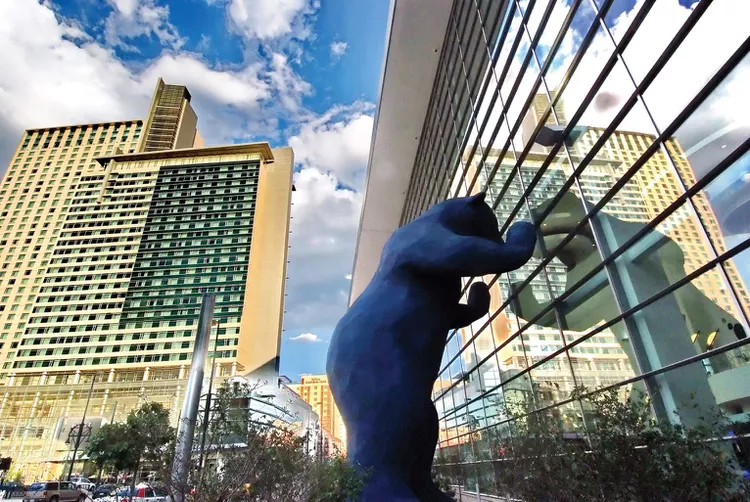Summary of Denver’s Architectural Wonders
Denver doesn’t necessarily have a distinct style of architecture that defines it. Rather, it ranges from late-era Victorian homes to super-sleek modern buildings. If you take yourself on an architecture treasure hunt in the city, you can tick all of the following off your list: a castle, an Italian-inspired clock tower, a massive blue bear, and a building that looks like a cash register. For the bonus round, head west into the foothills, and you can spot a home that looks like it’s straight from the Jetson’s.
Here’s where you’ll find seven of Denver’s most prized pieces of architecture.
The Denver Art Museum

The Rocky Mountains’ famed peaks inspired the bold, jagged look of the Denver Art Museums’ Frederic C. Hamilton Building. Designed by Daniel Libeskind and Davis Partnership Architects, it made its bold debut in 2006. Constructed with 9,000 titanium panels, the building reflects light, appearing rose-colored in the morning and golden at sunset. The Frederic C. Hamilton Building is Libeskind’s first completed building in the United States and was also chosen as a master plan architect for New York City’s World Trade Center site.
Colorado State Capitol

The spirit of Colorado’s gold rush is captured at the state Capitol, which took nearly 20 years to complete, finally debuting in 1908. More than 200 ounces of 24-karat gold leaf adorn the building’s dome, rising 272 feet into the sky. Modeled after the U.S. Capitol in Washington, D.C., the gold dome dazzles, but the real treasure lies inside. The entire world’s supply of Colorado Rose Onyx was used for the wainscoting, a stone that has not been discovered since.
Castle Marne

This stunning castle, located at the corner of 16th and Race Streets in Denver’s historic Capitol Hill neighborhood, serves as a bed and breakfast. Built in 1869 amid a construction boom in Denver, its architect, William Lane, is known for his eclectic designs. He was behind more than 300 homes in Denver and, despite his fame, succumbed to financial ruin during the “Silver Panic of 1893,” ultimately dying in 1897 as a “penniless pauper.” This Richardsonian Romanesque castle features a sturdy exterior made from lava stone quarried from Castle Rock, complemented by delicate details inside, including hand-carved fireplaces and a stained glass window from the Impressionist movement.
The Clock Tower

Denver was once home to the tallest structure west of the Mississippi—the historic Daniels and Fisher Department Store, rising 393 feet. Designed by architect F.G. Sterner in the Italian Renaissance style, this brick, stone, and terracotta structure provided stunning 200-mile views from its 20th floor. Unfortunately, the flagship store was demolished in the early 1970s; however, its grand clock tower was preserved, now hosting various events. This iconic tower is listed on the National Register of Historic Places, contributing significantly to Denver’s skyline.
The Colorado Convention Center

The Colorado Convention Center, completed in 2004, significantly altered Denver’s skyline with its extensive 660-foot-long roofline. This massive structure spans nine city blocks in downtown and includes a light rail station. A defining feature of the convention center is the 40-foot tall blue bear, named “I See What You Mean,” designed by artist Lawrence Argent. The bright blue color emerged from an accidental printout error, inspiring the artist’s choice.
The Cash Register Building

Downtown Denver’s “Cash Register” building is recognizable due to its red facade and curled roof resembling a cash register. Standing at 698 feet, it is the city’s third tallest building, creating an illusion of height due to its hilltop position. Inside, a spacious atrium showcases five LED panels, each 86 feet tall, that display dynamic images. This architectural gem was designed by Philip Johnson, known for his works such as the Glass House in Connecticut and New York’s Seagram Building.
Deaton Sculpture House

Situated just outside of Denver along Interstate-70 in Colorado’s foothills is a unique, saucer-shaped house resembling something from the “Jetsons.” Designed by architect Charles Deaton in 1963, this private residence is often referred to as “The Sleeper House,” notably for its appearance in Woody Allen’s 1973 sci-fi film “Sleeper.”





